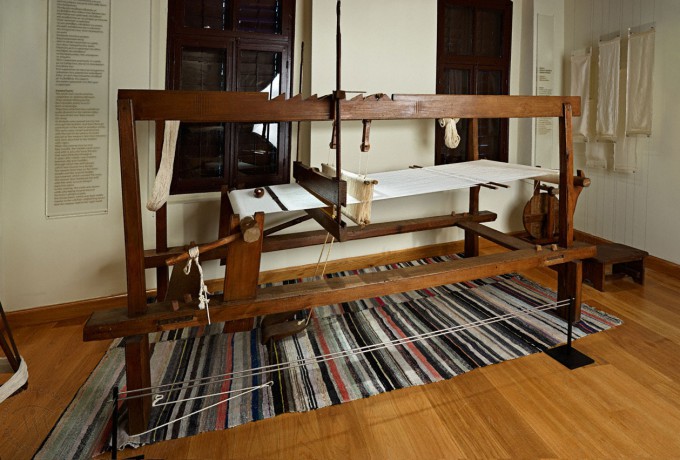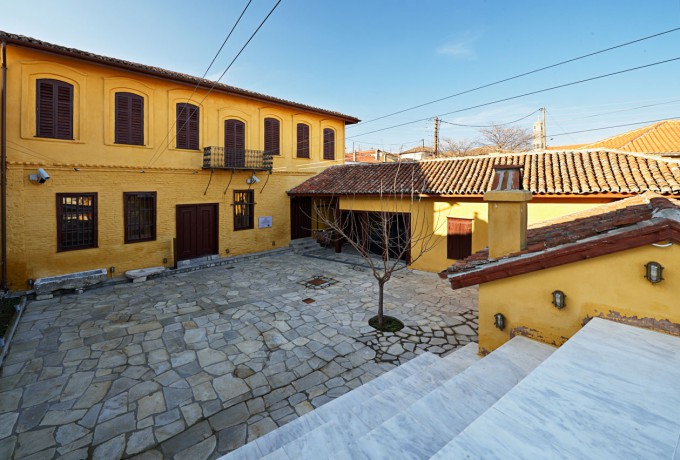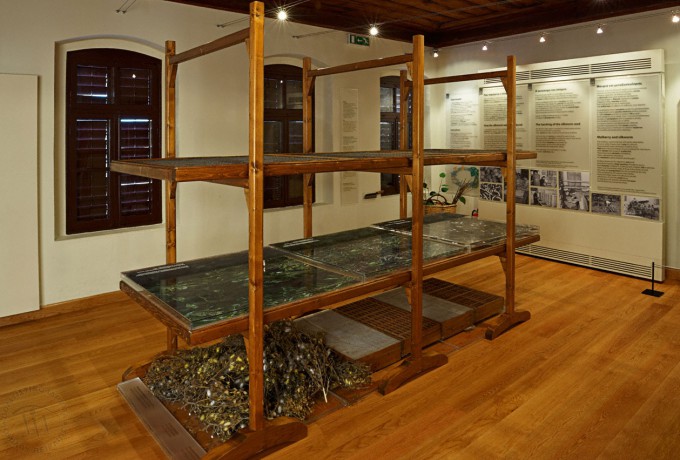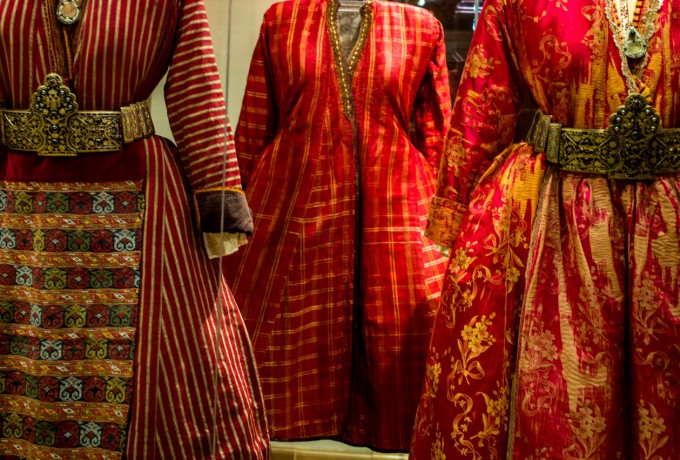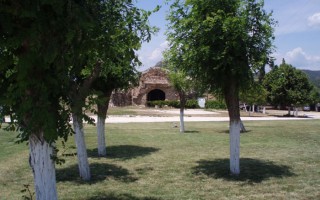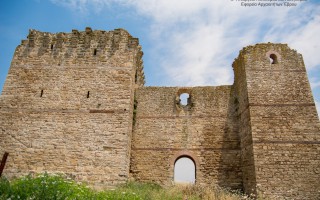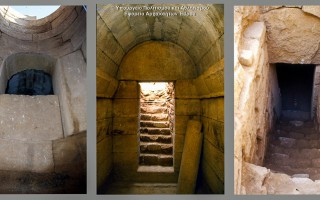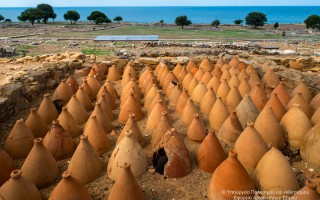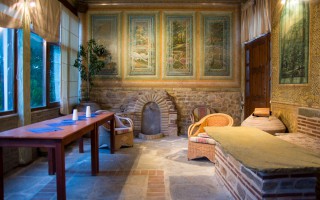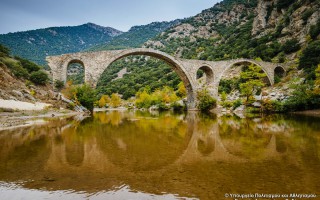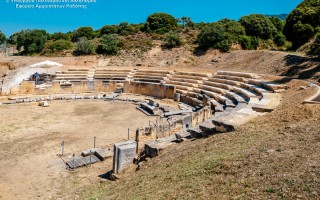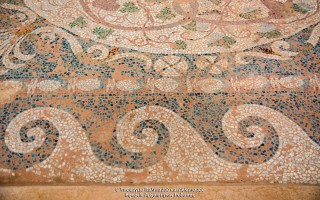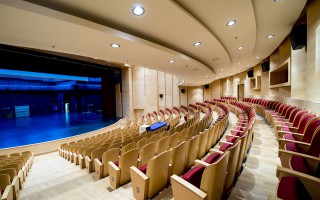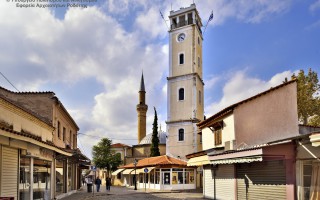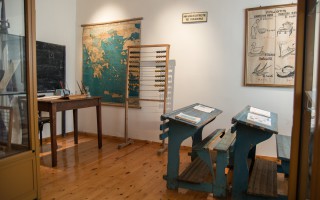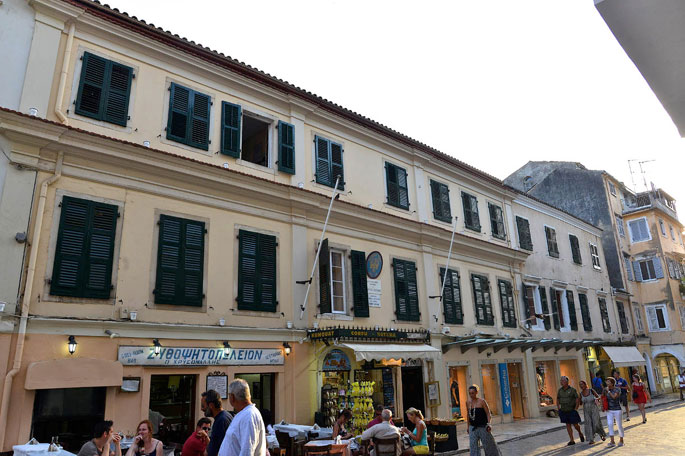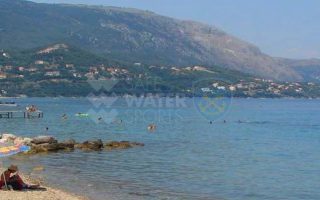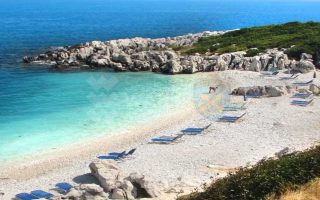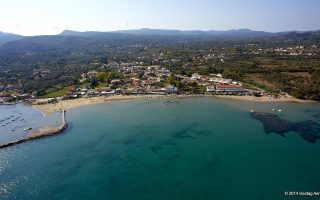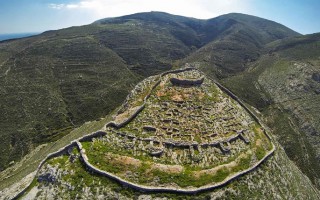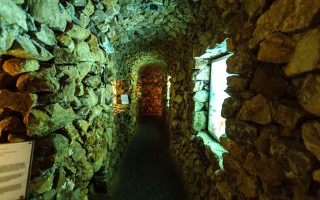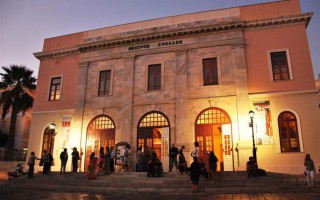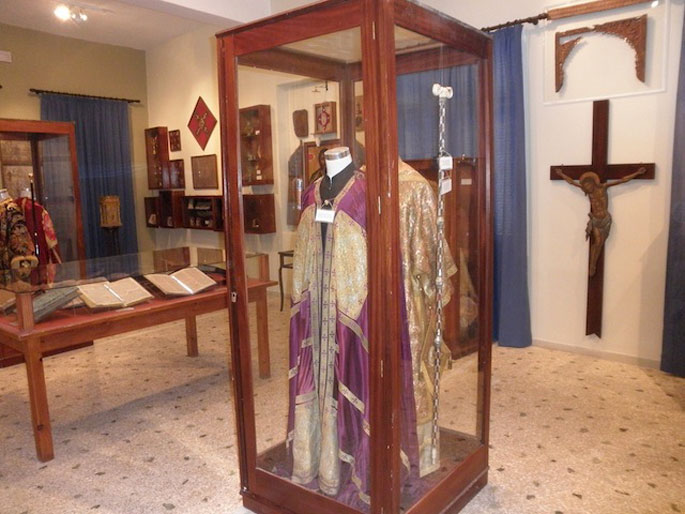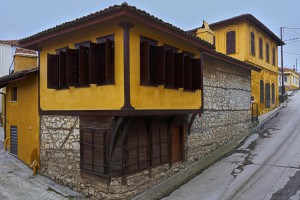 The Silk Museum details the phases of sericulture and silk industry.
The Silk Museum details the phases of sericulture and silk industry.
Operated by the Piraeus Bank Group Cultural Foundation and is housed in a neoclassical building of 1886, the mansion Kourtidi, located in downtown Soufliou which was renovated and opened in September 2008.
In the museum you have the opportunity to learn the history of natural silk route from China to Europe. It also shows all the phases and stages of the pre-industrial process of rearing silkworms
(sericulture) and processing of silk (silk), in the socio-economic context that made the region an important center of silk in Greece (late 19th – mid 20th century).
The documentary highlighted here help connect the sericulture and silk industry with specific spatial and temporal context.
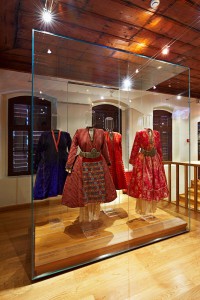 In the section “Costumes Soufli “will admire unique accessories of Soufli costumes.
In the section “Costumes Soufli “will admire unique accessories of Soufli costumes.
Young visitors have the opportunity to see reconstructions of all stages of silk processing.
The Museum organizes educational programs with games and activities for schools and group visits, such as the “Come to weave”, where children are taught the cycle of sericulture, the process of weaving and dyeing of silk.
Organized visits: for better service to visitors groups should be preceded prior arrangement with the Museum.
Persons with disabilities (PWD): The entrance for persons with disabilities are free. For group visits, tt is necessary the prearrangement with the Museum.
Mr Ahilleas Alexoudis
Source: Eastern Macedonia & Thrace
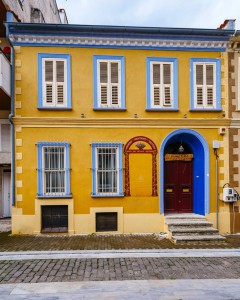 The Thracian Cultural and Ethnological Museum of Thrace, Komotini and set the house on the street Skouteri Kouloglou 10 and a donation of Royal Skouteri – Dintsoglou to the Municipality of Komotini. The architecture, decoration, furniture and objects from the
The Thracian Cultural and Ethnological Museum of Thrace, Komotini and set the house on the street Skouteri Kouloglou 10 and a donation of Royal Skouteri – Dintsoglou to the Municipality of Komotini. The architecture, decoration, furniture and objects from the
the Museum attach the life of the bourgeoisie of the city and the atmosphere of the time on the verge of 19th and 20th century. The Skouteri house built in the late 19th century at the same time as the adjacent listed building which was the residence of the brothers Telonidi. The family settled in Komotini Skouteri coming from the mainland and this house was the residence of the family until the second half of the 20th.
In simple neoclassical lines, the building exemplifies the architecture residence modern era of the bourgeoisie of Thrace. It”s probably built by craftsmen from Epirus. Incorporates domestic art building with, of European origin, frescoes on the walls of the first floor.
Source: Eastern Macedonia & Thrace
διαβάστε περισσότερα
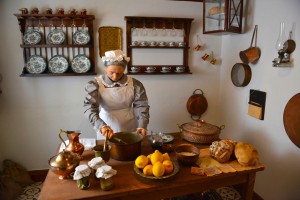 The Living History Museum Casa Parlante opened to the public in March 2014. Our name is a reference to the strong Italian cultural and architectural influence in Corfu.
The Living History Museum Casa Parlante opened to the public in March 2014. Our name is a reference to the strong Italian cultural and architectural influence in Corfu.
Located in central Corfu Town, Casa Parlante recreates the environment of an historic mansion, by depicting the everyday life of 19th century nobility. It includes animated figures and features the essences and sounds of the age, creating an authentic and involving experience.

Casa Parlante is one of the winners of the Hellenic Entrepreneurship Award 2013, under the name “Corfu Living History”.
Museum’s Website: www.casaparlante.gr/
The Museum of Cycladic Art was founded in 1993 by John and Helen Vati and it is housed in the cultural center of Hermoupolis. The Museum hosts replicas of the Goulandris Museum in Athens and organises various educational programs, games and recreational activities as well as tours for children and adults in order to take them on a historical journey through findings of Cycladic culture of the 3rd millennium BC.
The Little Tourguides
The young students of Syros acquire the role of the tourguide and take visitors on the most amazing tour of the island, from the City Hall to the Apollon theater, the Museum of Cycladic Art Replicas and the scenic area of Ano Syros. The tour takes place in Hermoupolis from Monday to Friday from 11:00-13:30 and every Tuesday from 19:00-21:00 at Ano Syros.
Director of the Museum: Mrs. Maria Rota, Archaeologist
Source: www.syrosisland.gr
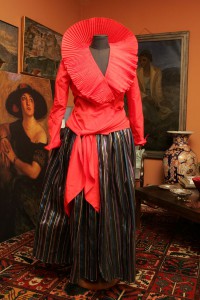 “The Cybeli Institute is a Cultural Institution that explores the theatrical history and the historical fortunes of Hellenism, it highlights concurrent processes in the European and international landscape, creates cultural synergies and promotes the cultural decentralization focusing on the Aegean, having as starting point the adventure of a large family which marked the theater, the politics and the arts of the Greek 20th century.
“The Cybeli Institute is a Cultural Institution that explores the theatrical history and the historical fortunes of Hellenism, it highlights concurrent processes in the European and international landscape, creates cultural synergies and promotes the cultural decentralization focusing on the Aegean, having as starting point the adventure of a large family which marked the theater, the politics and the arts of the Greek 20th century.
Its purpose is the preservation, research, utilization and promotion of all historical material about the Greek and European theatre of the 20th century, through the life and work of the leading lady Cybeli and her family.”
Cybeli web site: www.kyveli.eu
Source: www.syrosisland.gr
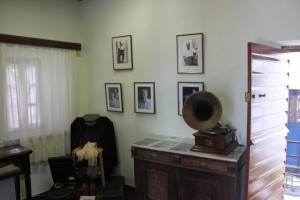 A voice perfectly intertwined with the “rebetiko” style of music succeeded in familiarizing all Greeks with the beauties of Syros with the most beloved song “Fragosyriani” thus showing his love for his homeland.To honor the works of this exceptional songwriter the people of Syros founded the Markos Vamvakaris Museum in a renovated but traditional home in the heart of Ano Syros so as to take visitors back in time through the voice, the lyrics and the life lead by this beloved “rempeti”, through his personal belongings, his photos, manuscripts and clothing through a half-hour documentary showcasing his life in the basement of the museum.
A voice perfectly intertwined with the “rebetiko” style of music succeeded in familiarizing all Greeks with the beauties of Syros with the most beloved song “Fragosyriani” thus showing his love for his homeland.To honor the works of this exceptional songwriter the people of Syros founded the Markos Vamvakaris Museum in a renovated but traditional home in the heart of Ano Syros so as to take visitors back in time through the voice, the lyrics and the life lead by this beloved “rempeti”, through his personal belongings, his photos, manuscripts and clothing through a half-hour documentary showcasing his life in the basement of the museum.
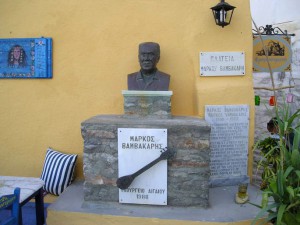 From the bust in his honor found on the homonymous square all the way to the museum a great tribute has been paid to this “Patriarch” of Rembetika music.
From the bust in his honor found on the homonymous square all the way to the museum a great tribute has been paid to this “Patriarch” of Rembetika music.
Working Hours:
Saturday – Sunday
From 12:30 to 18:30
Source: www.syrosisland.gr
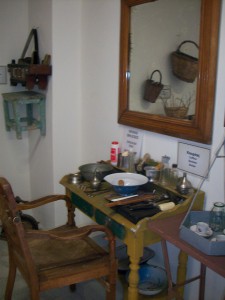 The Traditional Professions’ Exhibition is located in a building on the road Don Ioannou Stefanou in Ano Syros and it is an exhibition of objects used by the locals in their daily lives. From the barber’s scissors, the counter of fisherman, the carpenter’s tools, the agricultural equipment used by farmers, the smoker of beekeepers and various household objects such as petroleum lamps, oil lamps and sewing machines a visit to the Museum will certainly lure visitors to the daily life of a bygone era. The Exhibition of Traditional Professions is available to the public from early June to late September between 11:00-14:00 and 19:00-22:00.
The Traditional Professions’ Exhibition is located in a building on the road Don Ioannou Stefanou in Ano Syros and it is an exhibition of objects used by the locals in their daily lives. From the barber’s scissors, the counter of fisherman, the carpenter’s tools, the agricultural equipment used by farmers, the smoker of beekeepers and various household objects such as petroleum lamps, oil lamps and sewing machines a visit to the Museum will certainly lure visitors to the daily life of a bygone era. The Exhibition of Traditional Professions is available to the public from early June to late September between 11:00-14:00 and 19:00-22:00.
Working hours:
Saturday – Sunday
From 12:30 -18:30
Source: www.syrosisland.gr
 The ecclesiastical Museum of Ermoupoli was created from the initiative taken by the Metropolitan Bishop of Syros Dorotheos A’ in 1984 who managed to create an exceptional collection of ecclesiastical exhibits by sending the Archimandrite at the time being and current Bishop of Syros Dorotheo B΄ to collect various icons, sacred relics, utensils and pontificals from the churches and temples of the remaining islands of the metropolis. The Museum is housed in a building owned by the Sacred Metropolis and has been enriched over time with more pontificals, sacred relics and jewelry.
The ecclesiastical Museum of Ermoupoli was created from the initiative taken by the Metropolitan Bishop of Syros Dorotheos A’ in 1984 who managed to create an exceptional collection of ecclesiastical exhibits by sending the Archimandrite at the time being and current Bishop of Syros Dorotheo B΄ to collect various icons, sacred relics, utensils and pontificals from the churches and temples of the remaining islands of the metropolis. The Museum is housed in a building owned by the Sacred Metropolis and has been enriched over time with more pontificals, sacred relics and jewelry.
The Museum also houses a laboratory for creative activities and for the expression of children and offers hagiography lessons on the ground floor of the Temple of St. Nicholas that was later transferred to another privately owned place of the Sacred Metropolis along with the Theognosia bookstore near the Temple. Cycladic folklore items were also added to the exhibits and are now available for the public while the visit is free.
Source: www.syrosisland.gr
The Industrial Museum of Ermoupoli was founded in 2000 by the Center of Technical Culture and it is housed in 4 industrial buildings of the 19th century, the Kornilaki Tannery , the Skagiopoieio Anairoysi, the Velissaropoulou weaving mill, the Katsimanti paint factory against the General Hospital of Syros.
The Museum hosts a collection of tools, equipment and machinery from the Golden industrial era from loukoumi workshops, to textile, tanning, printing, machinist’s craftsmanship and glass workshops as well as a digital audio and visual archives with testimonies from former workers, maps and plans, a three-dimensional representation of industrial buildings and artifacts from the wreck of the Patrice steamship. Among the exhibits one can also see the first legendary electric car Enfield 8000 constructed in Greece.
Working Hours:
Monday to Friday 10.00 – 15.30
Saturday 10.00 – 15.30 & 18.00 – 20.00
Sunday 10.00 – 15.00
Source: www.syrosisland.gr
 The archaeological museum of Syros was founded in 1834 and it is one of the oldest museums of Greece. Since 1899 it is housed in 4 rooms of the City Hall of Ermoupolis and offers an independent entrance from the historic square. The Museum’s collections include exhibits such as the Amfikypellon, a tubular cup 15 cm in height from the end of the 3rd millennium, a compass, a vase 7 cm in height from the second half of the 3rd millennium, a marble statuette of a female figure 35 cm in height from 730 BC and other artifacts, sculptures and inscriptions from the early Cycladic and Byzantine period. The museum also hosts works of the archaeologist Christos Tsountas.
The archaeological museum of Syros was founded in 1834 and it is one of the oldest museums of Greece. Since 1899 it is housed in 4 rooms of the City Hall of Ermoupolis and offers an independent entrance from the historic square. The Museum’s collections include exhibits such as the Amfikypellon, a tubular cup 15 cm in height from the end of the 3rd millennium, a compass, a vase 7 cm in height from the second half of the 3rd millennium, a marble statuette of a female figure 35 cm in height from 730 BC and other artifacts, sculptures and inscriptions from the early Cycladic and Byzantine period. The museum also hosts works of the archaeologist Christos Tsountas.
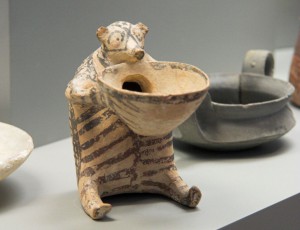 Working Hours:
Working Hours:
During Summer until 31st of October, daily from 08:00 – 20:00.
Source: www.syrosisland.gr


